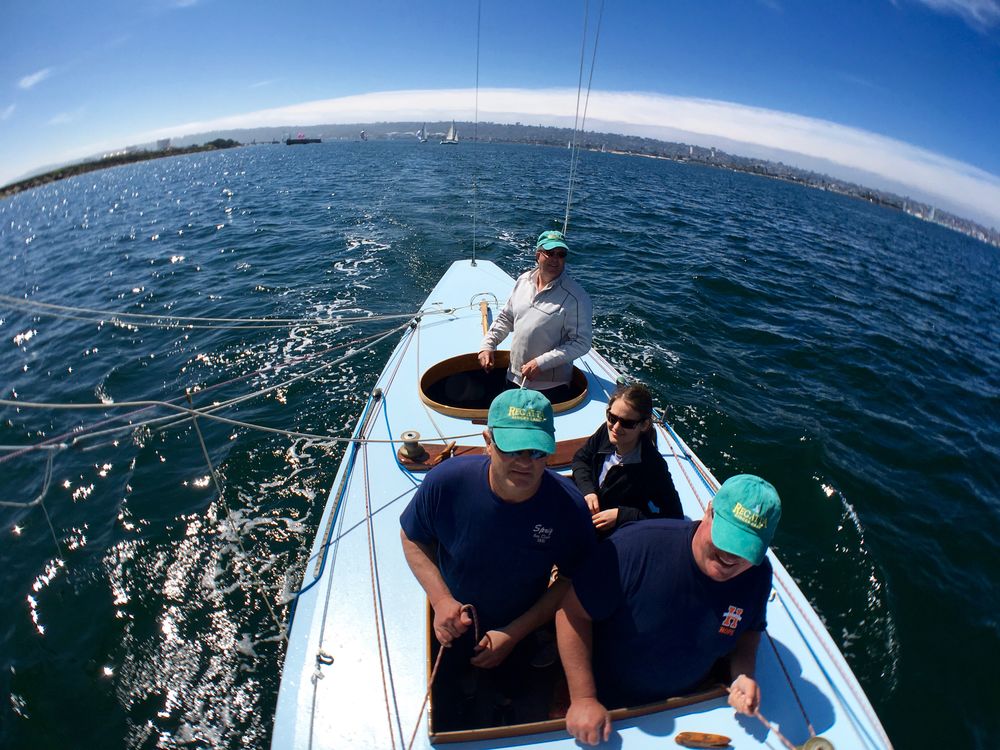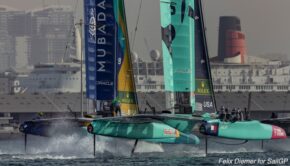Appreciating Classic Yacht Racing
Published on July 27th, 2017
It only takes Dave Reed of Sailing World one race to appreciate the attraction to classic yacht racing.
I’ll accept any invitation to race, but I do prefer faster, more-modern rides because, you know, I have to do it while I’m young. I’m not ready to ease into my slow-boat golden years, so when I agreed earlier this year to crew at the 6-Metre World Championship in Vancouver this fall, I did so with some apprehension.
Greg Stewart needed a bowman, and I can certainly get a good line sight, end-to-end a spinnaker pole, and ring the bell, but I have no clue what doing bow on a 6-Meter entails. Plus, heavy keelboats with long overhangs just aren’t my thing.
When I laid eyes upon Stewart’s baby-blue 6-Meter Sprig in its slip at the San Diego YC, however, a little chill went up my sailing shorts. Its coamings and trim are varnished and shiny, its authentic bronze hardware seasoned, and topsides polished. It sure is pretty; I think to myself, but man, it looks painful. And old. And if I race this thing, it makes me old too, right?
But like the 8-Metres of Toronto, there’s something magnetic about antique International Rule boats. To sail on one is to become part of its history. I can imagine all the sailors before me who have wrapped fingers around its long wooden tiller, feeling the power of the overlapping genoa that swallows the boat whole. When I stand before the mast and scan my future workspace, I appreciate the bowmen who’ve come before me, those who’ve tiptoed to its pointy end without fear of being pitched overboard.
No one appreciates Sprig better than Stewart, though. He’s sophisticated and intelligent, a renaissance lady’s man, and Sprig, his soulmate. He gives me a brief oral history: Sprig was built in City Island, New York, in 1930, as US43, and the guy he bought it from owned it for 25 years. Stewart bought it because “it’s sleek, there’s no plumbing, no head, no engine, no anything.” Plus, it’s the only one in town.
As a traditional 6-Meter, it’s all about the wood: mast, boom and spinnaker pole, and every 6-meter is unique. His has three “holes.” He steers from the back hole and does his own mainsheet; the middle hole houses the floater, who handles the runners, as well as the trimmers. The forward hole is reserved for the bowman. High coamings keep water out, for the most part. “People jump on and say the coamings are uncomfortable,” he jokes, “but I tell them: ‘That’s not where you’re going to sit. You’ll be down below.”

While racing upwind, 6-Meter crews hunker down below. Bree Williams and Doug Ver Meulen, Sprig regulars, have spent many hours staring at the wood.
Like Sprig’s previous owner, Stewart has owned it for decades. He’s a naval architect by trade, so he knows how to make this lady sail to her potential. He knows her moods, her tendencies, her likes and dislikes.
I joined him for the Helly Hansen NOOD Regatta’s North Sails Rally Race, an afternoon pursuit race around navigational marks in San Diego Bay. It’s an opportunity for me to experience what I’ve signed on for. The bow setup is straightforward, hanks on the jib and halyard exits at the mast, but the foredeck is slippery and narrow, and it takes all my core strength to remain planted as we lurch over powerboat wakes en route to the start. I can imagine what it’ll be like in Vancouver’s steep chop and strong winds.









 We’ll keep your information safe.
We’ll keep your information safe.